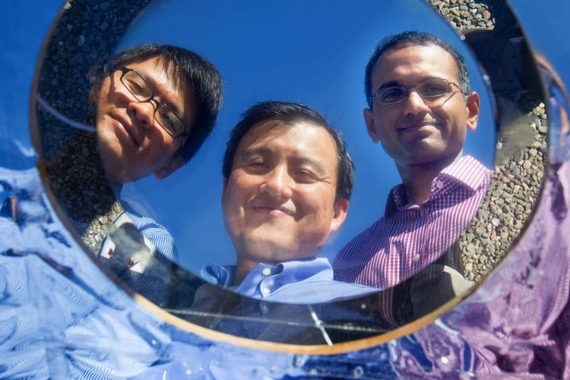When we think of new technologies for the coming year, the latest models of smartphones and other electronic devices come to mind. But while there is no doubt that it is the range of digital technologies on offer to the consumer that sets the major market trends, technology is not just digital, nor are the products we will see appearing this year at the cutting-edge, but rather the commercial exploitation of innovations from previous years. On the other hand, there are other offerings that are currently blazing a trail towards new frontiers.
In 2021 we are also awaiting the solution to a pandemic, which requires us to put our entire technological arsenal into play. Added to this is the ongoing challenge of climate change, which demands sustainable solutions from us. Here we review some technologies to keep an eye on in 2021, according to the predictions of experts and specialised media.
Designer drugs
Among the various lines of biomedical research that the COVID-19 pandemic has compelled us to pursue, and if 2020 was the year of vaccines, 2021 could be the year of new designer drugs. The potentially useful drugs against the SARS-CoV-2 coronavirus that we have seen so far, such as remdesivir or dexamethasone, are compounds that already existed before the appearance of this pathogen. However, the time is nearing when the deployment of drugs specifically tailored to fight the new virus will begin.

According to the journal Science, designer drugs against COVID-19, aimed at blocking the virus or treating its symptoms, form one of the major scientific endeavours to be pursued in 2021. More than 590 experimental compounds custom designed against SARS-CoV-2 are currently under development thanks to supercomputing and artificial intelligence (AI), and which act by preventing the virus from reproducing, for example by inhibiting one of its two proteases. Although these drugs will have to meet the requirement for clinical trials, previous experience with vaccines has shown that the process can be accelerated to respond quickly to the ongoing crisis. Researchers are confident that effective therapeutic cocktails such as those already used successfully against HIV can be developed.
Anti-COVID-19 technologies
The urgency of the pandemic has also introduced a new trend of technological innovations at the Consumer Electronics Show (CES), the world’s largest showcase of new consumer technologies that is presented every January in Las Vegas, and that this year had to be held virtually. Anti-COVID-19 technologies do not fall within a defined category, but rather form an extremely heterogeneous set of approaches aimed at combating the spread of the virus or at making people’s lives easier in these times of pandemic.
The medical technologies unveiled at this year’s CES include wearables and telemedicine devices, intelligent masks that send data on breathing and air quality to a smartphone, new body temperature scanners, portable air purifiers that can be carried in a bag and AI-based apps for measuring certain health parameters from a person’s facial image in a smartphone camera. But there are also new consumer devices and systems to facilitate teleworking, remote learning and connectivity in quarantine or lockdown situations, in short, the optimisation of the digital workplace, in what the consultancy firm Deloitte has defined as “the world’s largest unplanned work-from-home experiment.” As Alex Tsepko, CEO of the Skylum company, writes in Forbes, COVID-19 has accelerated technology in a way never before seen, with the field of digital health driving the advancement of AI, robotics, machine learning, Big Data analysis and the multi-connectivity of smart devices.

Smart Cities technologies
The implementation of new technologies in urban agglomerations aims to improve the quality of life of their inhabitants, which also involves the need to find environmentally sustainable formulas, reducing the carbon footprint and energy consumption. This is the context in which a fast-growing area of research is taking place, that of passive air-conditioning by means of radiative cooling. The aim is to create high-tech materials, in the form of claddings or paints, capable of dissipating heat from buildings without heating the air around them, using the chill of deep space as a heat sink. There are numerous approaches under development in this field, some of which are already being tested in real settings.

Also in the sphere of smart cities, another line of research seeks to design new materials that will help improve the management of wireless connectivity without increasing energy consumption. One example is the electromagnetic engineered surfaces from the company e2ip and the Communications Research Centre of Canada, which have won one of the CES 2021 innovation awards in the Smart Cities category. These are thin, semi-transparent plastic sheets that can be applied to indoor or outdoor surfaces and are capable of augmenting, directing or blocking specific radio frequencies, allowing for improved connectivity within an enclosure or for shielding communications.
New solutions for sustainable mobility
Cleaner and more efficient cars are by no means a new trend. According to the UK Society of Motor Manufacturers and Traders (SMMT), a 2018 model emits 31% less CO2 than a 2000 model, and 20% less than the average vehicle in use. But despite this general trend, emissions from new cars also increased by almost 3% in 2018 to 124.5 grams per kilometre, a paradox that can be explained by two key factors: larger cars are being bought and the number of diesel vehicles in use, which emit less CO2, is falling.

However, the demand for less polluting vehicles is now more pressing than ever. In Europe, EU regulations require manufacturers to ensure that from this year onwards their vehicle emissions do not exceed 95 g/km. And according to experts, the market for electric cars is not yet ready to completely replace the combustion engine. This is why, according to The Engineer magazine, some companies are seeking to innovate in many fields, from halving the weight of vehicles with composite materials and modular parts that allow assembly in microfactories, as proposed by the French company Gazelle Tech, to inventing “the Netflix of cars”, a proposal by the American company Canoo which offers monthly subscriptions to its innovative seven-seater electric vehicles, described as “an urban loft on wheels.”
Less presence, more mixed or extended reality
For years we have seen the expansion of virtual reality (VR) and augmented reality (AR) systems; the former introduce the user to a simulated environment, while the latter add information to the visualisation of reality. Although these systems have not yet become widespread beyond entertainment and gaming, it would be difficult to describe them as new technologies. Nevertheless, numerous media and experts agree that 2021 will be a hot year in the take-off of mixed or extended reality (XR), which encompasses the previous concepts. This is not so much because of the appearance of revolutionary new devices, but rather because of incremental improvements that will extend their use to various settings, in many cases due to demands imposed by the pandemic: distance education and training, remote healthcare, collaborative teleworking, online shopping or travel and virtual attendance at sporting events or concerts.
Comments on this publication